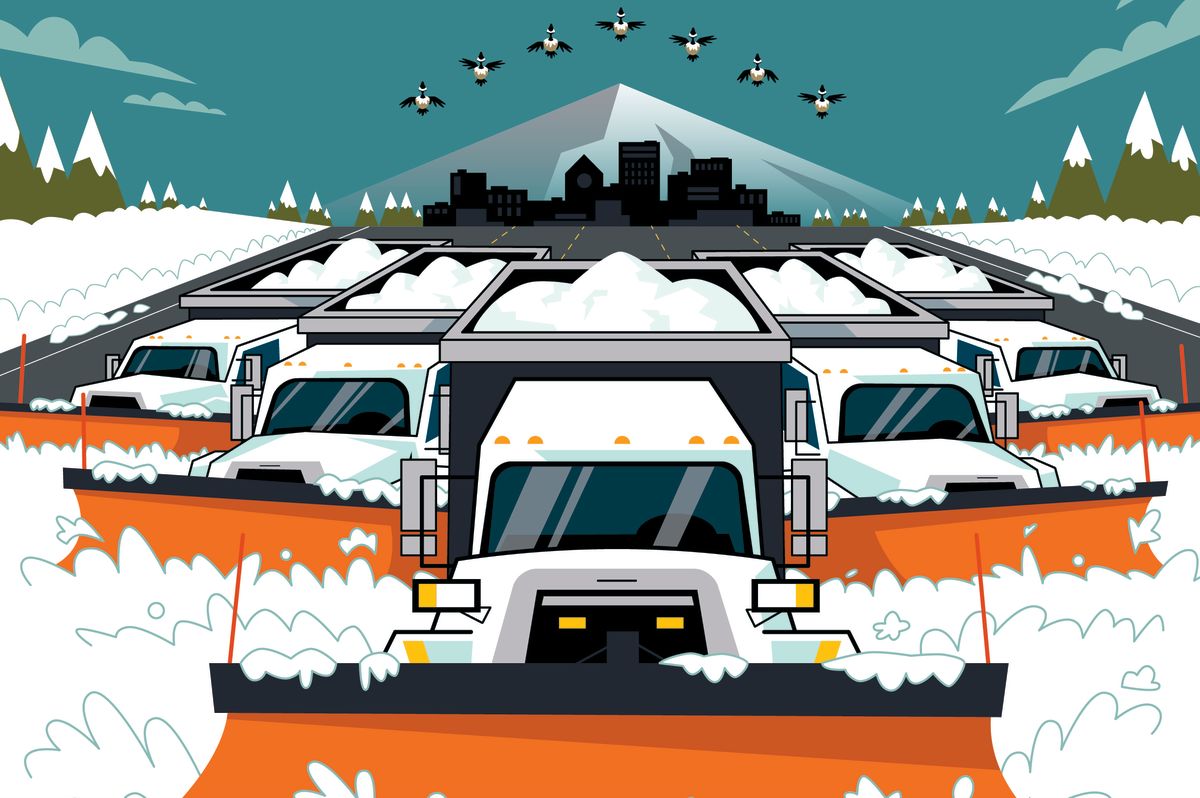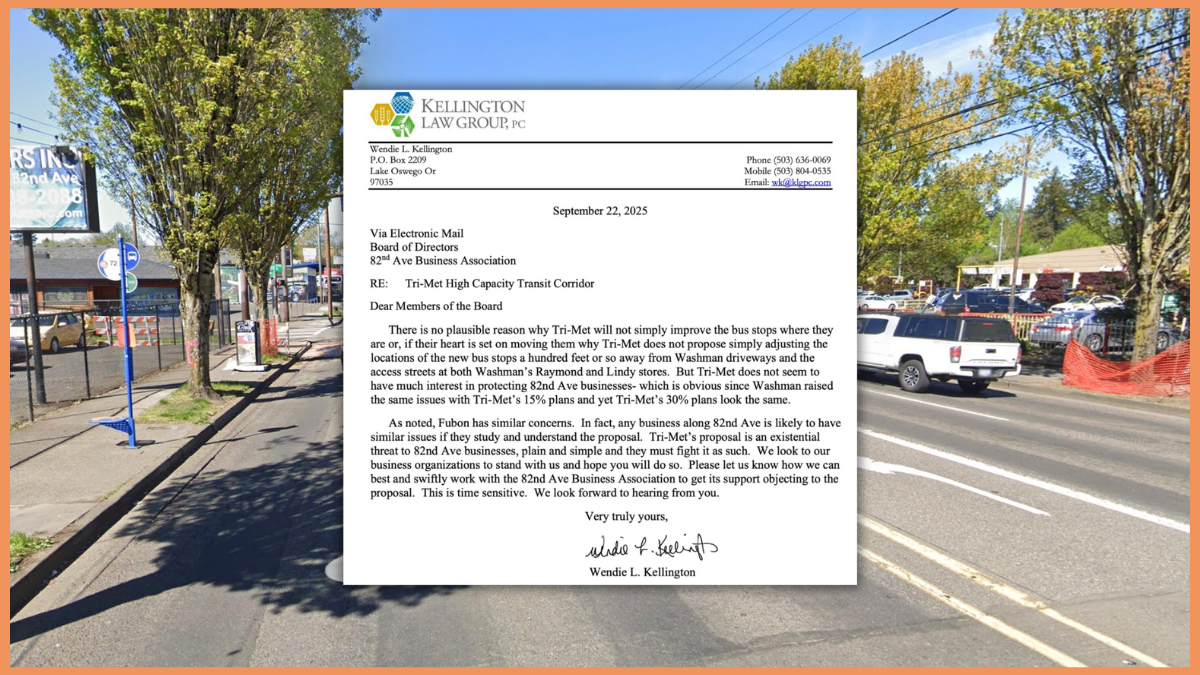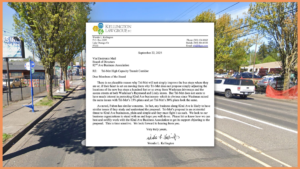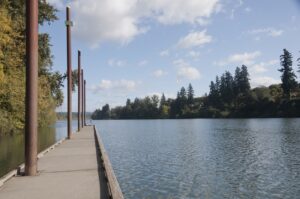Oregon’s Winter Weather Chaos, Explained

While I was growing up in Wisconsin, my father would say that we had two seasons: winter and July. We would trudge to class through snowdrifts every year; parents went to work, buses ran, life continued. Milwaukee averages 10 inches of snowfall each December; Portland, less than half of that in a whole year. It’s also more than 10 degrees warmer on average. So when I arrived in Oregon, winters felt positively balmy by comparison.
And then we were hit with last winter. In January, an ice storm brought sleet and frigid temperatures that lingered for days: Thousands lost power. Streets and freeways became skating rinks. And people died—from hypothermia, fallen trees, electrocution from downed power lines.
Each year, Oregon’s winter storms and their repercussions instigate conversations about the state’s ability to handle extreme weather. Midwestern expats blame Oregon drivers, or an assumed lack of salt on roads (Portland has used rock salt, among other deicers, since 2017). Some locals defend the current allocation of resources, noting Portland’s relatively low number of snowy days. Others think we need to beef up our defenses: Last winter, the Independent Restaurant Alliance of Oregon sent a letter to Gov. Tina Kotek and other local leaders, requesting financial relief for businesses that lost revenue and infrastructure improvements to keep roads drivable. “It is long past time for city and state leaders to acknowledge that extreme weather events are not an anomaly,” the letter reads. “We must invest in infrastructure to navigate these challenges.”
Whether you agree with the state’s concerned restaurant owners, their letter hits at a major issue regarding how we navigate winter amid climate change: money. Specifically, the Oregon Department of Transportation’s lack of it.
After ODOT, which is tasked with preparing Oregon roads for winter storms, warned that a significant budget shortfall could impact road safety, Kotek secured an extra $19 million in funding for winter road maintenance through late 2025. And in September, the Federal Highway Administration agreed to send the state just under $43 million in funding for infrastructure improvements related to natural disasters—including storms.
But things still look grim: The agency has again sounded the alarm, estimating a shortfall of $354 million and 1,000 jobs lost between 2025 and 2027 if the state legislature doesn’t intervene. ODOT spokesperson Kevin Glenn says the long-term crises for the agency are driven by flat gas tax revenues (blame your Tesla), inflation (blame whatever politicians you don’t like), and ODOT’s debt service (blame late-stage capitalism?).
“As a result of our structural revenue issue, we anticipate a significant reduction in winter service levels beginning in late 2025,” says Glenn. He expects the agency will be able to purchase only around 50 percent of the salt, deicer, and abrasives it usually does, which means reduced service levels on interstates and highways and even more limited service on less-traveled roads.
This is less of a concern in Portland proper, where Portland Bureau of Transportation (PBOT) spokesperson Dylan Rivera says its budget is adequate. During a snowstorm, PBOT maintains 1,749 miles of snow and ice routes, compared to the 4,875 total miles it maintains year-round. The city specifically focuses on these routes because of its staffing and resources, but also its objectives. Many Portland roads are simply too steep or narrow to safely plow, and drivers may make risky choices if they believe the streets are passable. During a storm, PBOT isn’t trying to get as many cars on roads as possible; rather, it’s making sure public transit can continue to run safely and snowplows can clear routes for emergency personnel.
But when we talk about Portland “snowplows,” we’re rarely referring to actual plows.
“We have a fleet of 55 dump trucks used for street maintenance year-round,” says Rivera. “When snow and ice are forecast, we attach a plow to the front of those vehicles and a sand spreader to the back. That’s how we get 55 snowplows in Portland.”
While PBOT handles local roads, ODOT pilots snowplows on highways. “We try and plow like geese flying,” says ODOT maintenance manager Kent Kalsch. “One plow truck in the center and then the next plow truck and the next one.” But impatient drivers create more risks, attempting to pass and cut between the staggered plows. Too often the result is a crash. Kalsch’s theory is that anti-lock braking systems and collision warnings create a false sense of security among drivers.
“People are overdriving their vehicles because of all these enhanced safety features,” he says. “If you’re driving as fast as you think you can, you’re probably driving 10 miles an hour too fast.”
Similarly, our relatively recent adoption of rock salt as a deicer is not the roadway cure-all some drivers think it is. Sure, the salt now used on I-84 and I-5 in Oregon melts snow fast, but it doesn’t immediately make driving easier or safer. “When we used to plow snow, it was light and fluffy or wet,” says Kalsch. “Now everything is almost like a 7-Eleven Slurpee—wet and heavy because it’s melting all the snow and breaking it up so we can remove it and clear the road quicker.” But when new flurries fall on freshly salted slush, the snow is always at its slickest temperature, between 34 and 28 degrees.
Back in Wisconsin, and in other parts of the country where snow and ice are winter norms, infrastructure has been in place since the Model T to help drivers cope—from plows to salt, not to mention plow drivers to clear the white stuff. But Oregon isn’t Wisconsin. We have different priorities. The state uses less salt and sand—which can harm our water and air quality—than other places. And we have less snow, of course. But a little snow can cause a lot of problems, especially if the agencies in charge of plowing it aren’t fully funded.
Share this content:















Post Comment